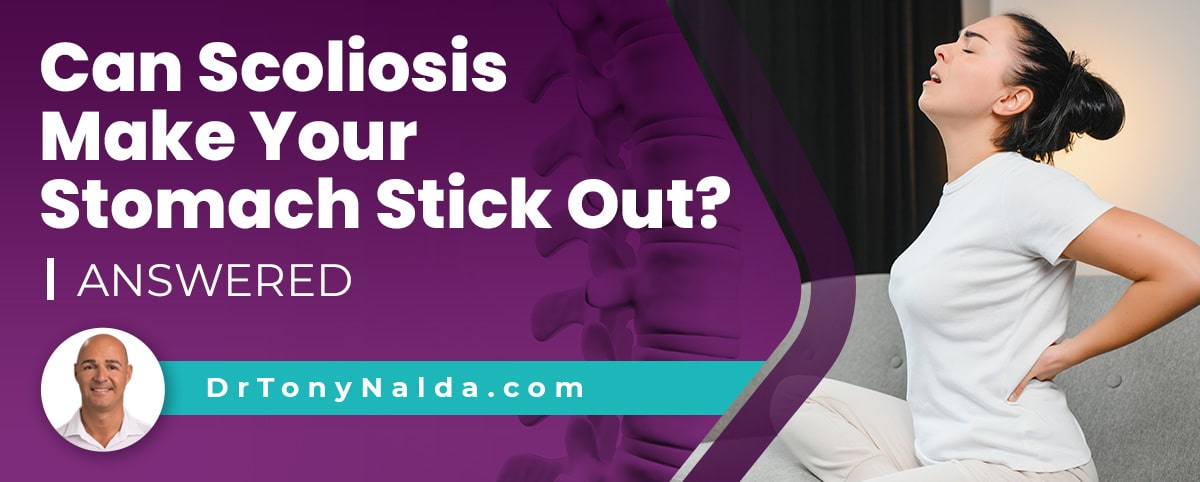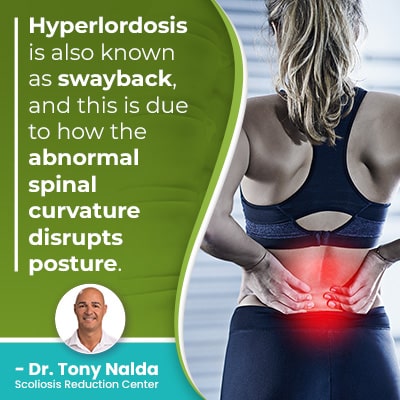Can Scoliosis Make Your Stomach Stick Out? [ANSWERED]

The spine's natural and healthy curves give it added strength, flexibility, and make it better able to absorb mechanical stress. There are a number of spinal conditions a person can develop that involve a loss of the spine's healthy curves such as scoliosis, hyperkyphosis, and hyperlordosis. Continue reading to find out which is most closely related to an excessively-protruding stomach.
While scoliosis symptoms can include a number of postural changes, a protruding stomach is more clearly linked with another prevalent spinal condition: hyperlordosis. Also known as swayback, hyperlordosis is the development of excessive lordosis in the lumbar spine.
To better understand the effect that unhealthy curves can have on the spine, let's first talk about the spine's natural curves.
Table of Contents
Healthy and Natural Spinal Curves
As the brain and spine work in tandem to form the body's central nervous system, any condition that affects the spinal cord can affect the entire body.
 Being diagnosed with scoliosis means an unnatural sideways spinal curve, with rotation, has developed.
Being diagnosed with scoliosis means an unnatural sideways spinal curve, with rotation, has developed.
It's natural for idiopathic scoliosis patients to wonder what types of changes they can expect, and as a structural spinal deformity, there are also different types of scoliosis a person can develop.
For those who have been diagnosed with scoliosis, it's important to understand the different treatment options available as traditional treatment tends to funnel scoliosis patients towards spinal fusion surgery, while conservative scoliosis treatment offers a non-surgical treatment response.
Adolescent idiopathic scoliosis is the condition's most-prevalent form, with neuromuscular, congenital scoliosis, degenerative scoliosis, and traumatic scoliosis considered atypical cases.
If a healthy spine is viewed from the sides, it will take on a soft 'S' shape, and when viewed from the front and/or back, it will appear straight; this is due to the spine's natural and healthy curves.
There are three main spinal sections, each with its own characteristic curvature type: cervical spine (neck), thoracic spine (middle/upper back), and the lumbar spine (lower back).
The two types of spinal curves are known as kyphosis and lordosis; kyphosis refers to the spine's outward curvature, bending away from the body's center in a reverse 'C' shape, while lordosis refers to the spine's curves that bend inwards, towards the body's center, in a standard 'C' shape.
The thoracic spine features a kyphotic curvature type, while the cervical and lumbar sections feature lordotic curves.
If a kyphotic or lordotic curve becomes excessive, it's referred to as hyperkyphosis and hyperlordosis.
What is Hyperkyphosis?
While there is a natural range of healthy kyphosis in the thoracic spine, if that range falls beyond a normal level, problems can occur; a healthy range of thoracic kyphosis would fall between 20 and 40 degrees.
When an exaggerated outwards curve develops in the thoracic spine, it can cause an excessive rounding of the back.
Hyperkyphosis can affect all ages, but is most prevalent in older women; age-related hyperkyphosis can be related to weak vertebrae becoming compressed or cracked and/or changes to bone density related to menopause.
Infants and adolescents can also develop hyperkyphosis due to a malformation within the spine itself, and when mild, the condition isn't associated with many noticeable issues, but when severe, it can cause pain, postural changes, and compressed spinal nerves.
Hyperkyphosis develops when the vertebrae become wedge-shaped, rather than rectangular-shaped as healthy vertebrae are, and the change in shape affects the spine's ability to maintain its natural curves and alignment.
Wedge-shaped vertebrae can be caused by fractures, osteoporosis, disc degeneration, Scheuermann's disease, spinal tumors/cancer treatment, birth defects, and certain syndromes such as spina bifida and muscular dystrophy.
So while mild hyperkyphosis isn't known to cause overt symptoms, in severe cases, and/or if left untreated, hyperkyphosis can cause varying levels of back pain and stiffness, tight muscles, and potential complications such as breathing problems, digestive system issues like irritable bowel syndrome, and limited function related to weak back muscles.
Now that we've addressed the spine's healthy degree of kyphosis and what can happen when a person's thoracic kyphosis becomes excessive, let's move on to addressing hyperlordosis and why it can cause the stomach to stick out.
What is Hyperlordosis?
As mentioned, while scoliosis is known to disrupt the body's overall symmetry, it's not associated with causing the stomach to protrude excessively; this is more closely linked to hyperlordosis.
A healthy range of lordosis at the cervical spinal section would fall within the range of 20 to 40 degrees, with a healthy range of lumbar lordosis falling within a range of 40 to 60 degrees.
As you can see, there is quite a range of healthy lordosis, and when it comes to how the condition affects the stomach, this is more closely related to excessive lordosis of the lumbar spine; it's the section of the body that's located closest to an unnatural spinal curve that is most likely to feel its direct effects.
Hyperlordosis can affect all ages, but isn't as common in children.
 Hyperlordosis is also known as swayback, and this is due to how the abnormal spinal curvature disrupts posture.
Hyperlordosis is also known as swayback, and this is due to how the abnormal spinal curvature disrupts posture.
Because the lumbar spine has an excessive outwards curve, it makes the buttocks protrude excessively at the back and the abdomen sticks out excessively at the front: stomach sticking out.
So what are some common causes of hyperlordosis?
Hyperlordosis Causes
While there are different causes of hyperlordosis, chronic poor posture is the most common, which is why, in some cases, the condition can be reversible if proactive efforts to correct posture are made, something physical therapy can also help with.
Obesity is another common cause of hyperlordosis; when a person is carrying excess weight, particularly in the abdomen and buttocks areas, this puts extra strain on the joints of the lower back, which can cause the lumbar spine to bend unnaturally.
Weak abdominal muscles (core) can also be a contributing factor to the development of an unnatural lumbar curve as it's not just the spine that's in charge of maintaining its natural curves and alignment, but also its surrounding muscles.
If a person has a weak core, this means the muscles surrounding the lumbar spine can't provide it with optimal support and stabilization.
Leading a sedentary lifestyle is another cause, not just because it contributes to obesity, but also because the very design of the spine is based on movement, and a lack of movement weakens the core muscles that support the spine, trunk, and pelvis.
In addition, it's through movement that the spinal discs replenish and restore themselves. As the largest structures within the body without their own vascular supply, if a disc becomes desiccated due to a lack of movement, it's difficult to reverse those effects.
Hyperlordosis can also be caused by the presence of spinal conditions such as hyperkyphosis, spondylolisthesis, and discitis.
The presence of hyperkyphosis can also lead to the development of hyperlordosis as when the spine loses one or more of its healthy curves, it can respond by putting in compensatory curves, so if there is excessive kyphosis in the thoracic spine, the sections above and below can put in compensatory curves to counteract its effects.
Spondylolisthesis can cause varying levels of lower back pain and involves a vertebra slipping out of place onto the vertebra below, placing tension and pressure on the lower vertebral body, and this can cause the section to become misaligned and lose its natural lordosis.
Discitis is caused by inflammation that develops between the discs of the spine, and the inflammation can put extra pressure on the discs, impairing their function and health, and as the discs provide the spine with structure, a deteriorating disc can mean the development of an unhealthy spinal curve.
Spinal stenosis is also related to hyperlordosis and involves a narrowing of the spinal canal, which can cause many patients to experience nerve compression.
Conclusion
So can scoliosis cause disruptions to the body's overall posture and symmetry: yes, it can.
However, common symptoms of scoliosis include uneven shoulders, shoulder blades, the development of a rib arch, and uneven hips; particularly if left untreated, and/or in severe scoliosis, potential complications can include issues with the digestive system, acid reflux, and can even affect internal organs.
Most scoliosis patients find that mild scoliosis doesn't produce overt symptoms, but progressive scoliosis changes symptoms and symptom severity as conditions worsen over time.
A prevalent spinal condition, known as hyperlordosis, is more closely related to causing the stomach to stick out excessively.
Lordosis refers to the spine's natural inward curvatures at the cervical and lumbar spinal sections, but hyperlordosis is more common in the lumbar spine and involves an excessive level of lordosis.
Also known as swayback, hyperlordosis affects posture by causing the buttocks to thrust outwards at the back, and the abdomen, and stomach, to protrude excessively at the front.
While there are different causes of hyperlordosis, the most common include lifestyle choices such as chronic poor posture, carrying excess weight, and leading a sedentary lifestyle.
When it comes to treatment for hyperlordosis, here at the Scoliosis Reduction Center, I proactively address the excessive lordosis by first determining its underlying cause.
Once I have determined the cause of hyperlordosis, I can craft a customized treatment plan that addresses the specifics of the patient and their abnormal spinal curvature.
Dr. Tony Nalda
DOCTOR OF CHIROPRACTIC
After receiving an undergraduate degree in psychology and his Doctorate of Chiropractic from Life University, Dr. Nalda settled in Celebration, Florida and proceeded to build one of Central Florida’s most successful chiropractic clinics.
His experience with patients suffering from scoliosis, and the confusion and frustration they faced, led him to seek a specialty in scoliosis care. In 2006 he completed his Intensive Care Certification from CLEAR Institute, a leading scoliosis educational and certification center.
About Dr. Tony Nalda
 Ready to explore scoliosis treatment? Contact Us Now
Ready to explore scoliosis treatment? Contact Us Now





